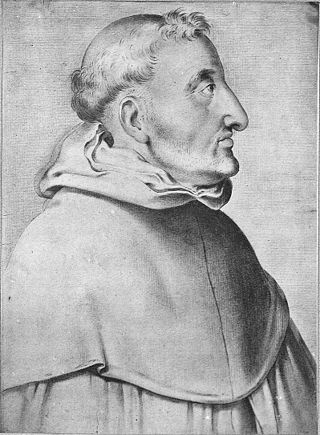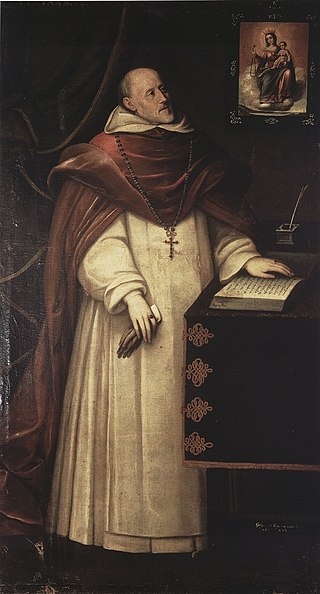
The Order of Preachers, commonly known as the Dominican Order, is a Catholic mendicant order of pontifical right that was founded in France by a Castilian priest named Dominic de Guzmán. It was approved by Pope Honorius III via the papal bull Religiosam vitam on 22 December 1216. Members of the order, who are referred to as Dominicans, generally display the letters OP after their names, standing for Ordinis Praedicatorum, meaning 'of the Order of Preachers'. Membership in the order includes friars, nuns, active sisters, and lay or secular Dominicans. More recently, there have been a growing number of associates of the religious sisters who are unrelated to the tertiaries.

Pope Benedict XI, born Nicola Boccasini, was head of the Catholic Church and ruler of the Papal States from 22 October 1303 to his death, in 7 July 1304.

Francisco Jiménez de Cisneros, OFM was a Spanish cardinal, religious figure, and statesman. Starting from humble beginnings he rose to the heights of power, becoming a religious reformer, twice regent of Spain, Cardinal, Grand Inquisitor, promoter of the Crusades in North Africa, and founder of the Alcalá University. Among his intellectual accomplishments, he is best known for funding the Complutensian Polyglot Bible, the first printed polyglot version of the entire Bible. He also edited and published the first printed editions of the missal and the breviary of the Mozarabic Rite, and established a chapel with a college of thirteen priests to celebrate the Mozarabic Liturgy of the Hours and Eucharist each day in the Toledo Cathedral.

Didacus of Alcalá, also known as Diego de San Nicolás, was a Spanish Franciscan lay brother who served among the first group of missionaries to the newly conquered Canary Islands. He died at Alcalá de Henares on 12 November 1463 and is now honoured by the Catholic Church as a saint.

Bartolomé Carranza was a Navarrese priest of the Dominican Order, theologian and Archbishop of Toledo. He is notable for having been persecuted by the Spanish Inquisition. He spent much of his later life imprisoned on charges of heresy. He was first denounced in 1530, and imprisoned during 1558–1576. The final judgement found no proof of heresy but secluded him to the Dominican cloister of Santa Maria sopra Minerva where he died seven days later.

Louis of Granada, was a Dominican friar who was noted as theologian, writer and preacher. His beatification process has been long open with the Holy See, with his current status being venerable.

Juan García de Loaysa y Mendoza was a Spanish Archbishop of Seville and Cardinal.

The Dominican Rite is the unique liturgical rite of the Dominican Order in the Catholic Church. It has been classified differently by different sources – some consider it a usage of the Roman Rite, others a variant of the Gallican Rite, and still others a form of the Roman Rite into which Gallican elements were inserted.

Bartholomew of Braga, born Bartolomeu Fernandes and in religious Bartolomeu dos Mártires, was a Portuguese Catholic and a professed member from the Order of Preachers as well as the Archbishop Emeritus of Braga. Fernandes participated in the Council of Trent and also collaborated with Charles Borromeo at the council while also establishing a series of hospitals and hospices in Braga while publishing a range of works from catechism to other topics.

Diego José de Cádiz (1743–1801) was a Spanish Capuchin friar who was a noted and popular preacher throughout the region of Andalusia during the 18th century. He was beatified by the Catholic Church in 1894.
William Houghton was an English Dominican who became a diplomat and Archbishop of Dublin.

The 17 Thomasian Martyrs were the 12 Dominican priests, 1 Franciscan priest and 3 Dominican bishops who became administrators, professors, or students in the University of Santo Tomas in Manila, they are venerated in the Catholic Church regarded them as a martyrs and declared as a saints and blesseds by several popes throughout the 20th and 21st century, All of them gave up their lives for their Christian faith, some in Japan, others in Vietnam, and in the 20th century, in Spain during the Spanish Civil War. Lorenzo Ruiz de Manila was among the lay companions of the Thomasian Martyrs of Japan, their feast day is celebrated every year on November 6.

John of Sahagún, OESA, was a Spanish Augustinian friar and priest. He was a leading preacher of his day, and was known as a peacemaker and reconciler of enemies among the nobles and factions of Salamanca. He was declared a saint by the Catholic Church in 1690 by Pope Alexander VIII.

Buenaventura García de Paredes was a Dominican priest and Master of the Order of Preachers.

Peter Nigri, known also as Peter George Niger, was a Dominican theologian, preacher and controversialist.

Antonio de Montesinos or Antonio Montesino, OP was a Spanish Dominican friar who was a missionary on the island of Hispaniola. With the backing of Pedro de Córdoba and his Dominican community at Santo Domingo, Montesinos was the first European to publicly denounce the enslavement and harsh treatment of the indigenous peoples of the island. His censure initiated an enduring struggle to reform the Spanish conduct towards all indigenous people in the New World. Montesinos' outspoken criticism influenced Bartolomé de las Casas to head the humane treatment of Indians movement.

The Convento de San Esteban is a Dominican monastery of Plateresque style, situated in the Plaza del Concilio de Trento in Salamanca, Castile and León, Spain.

Hyacinthe-Marie Cormier was a French Dominican friar and religious priest, who served as the 76th Master of the Order of Preachers from 1904 until 1916. Cormier was beatified by Pope John Paul II on 20 November 1994.

Cristóbal de Torres y Motones, OP was a Spanish-born prelate of the Catholic Church in New Spain. A member of the Dominican Order, in 1635 he was appointed archbishop of the Archdiocese of Santafé en Nueva Granada. There, he was one of the first bishops in New Spain to admit indigenous people to communion, and he later founded Del Rosario University in Bogotá.
Aniceto Fernández Alonso OP was a Spanish Catholic priest and the Master of the Order of Preachers from 1962 to 1974.

















